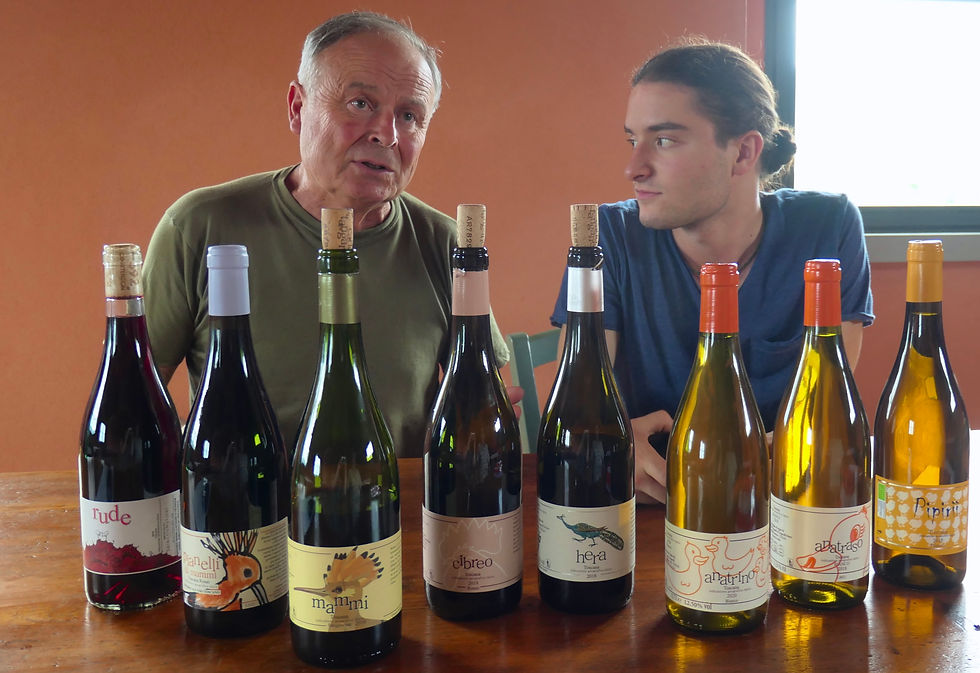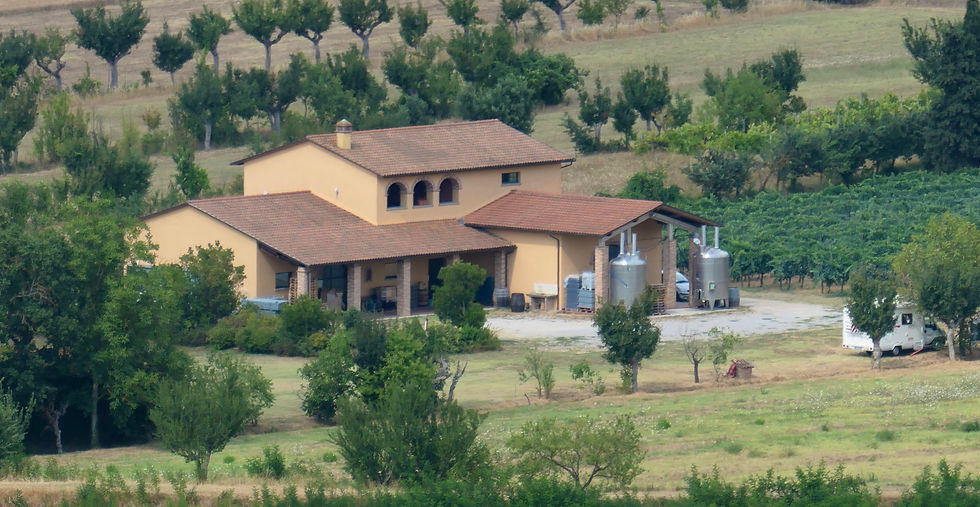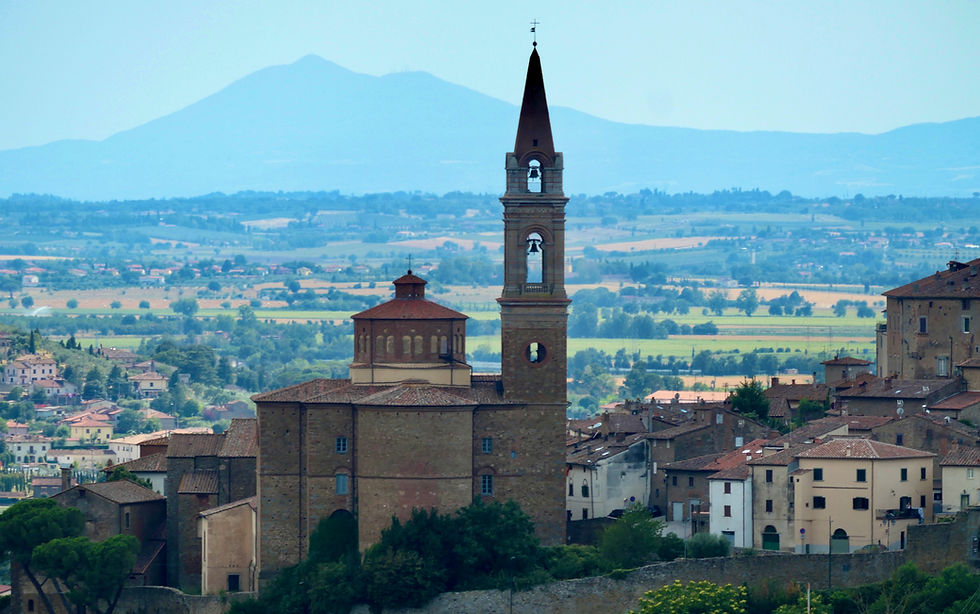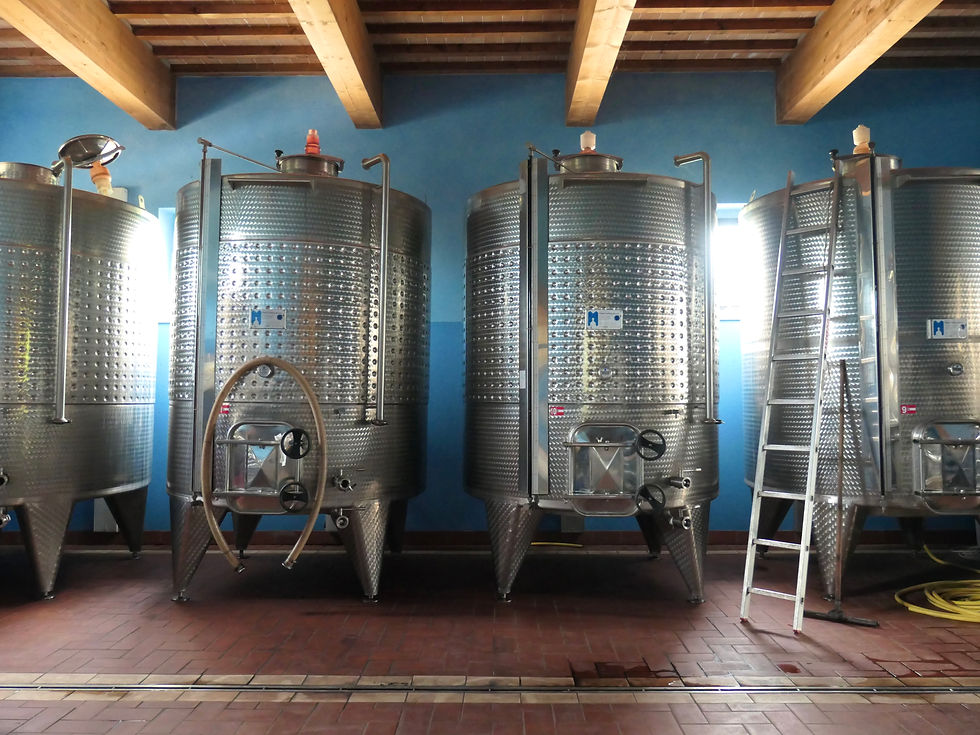
Tucked into the south-east corner of Tuscany hard by the Umbrian border, Castiglion Fiorentino is a town that was new to us despite the fact that we live in Tuscany year-round. Its much more famous neighbor, Cortona, lies barely 8 miles to the south and being the setting of several popular books and films, it tends to grab all the attention. So much the better perhaps, because even in the first few days of August Castiglion Fiorentino was quiet with no tour buses spoiling the mood or the scenery.

Away from the main road and higher up in the very attractive centro storico this is a surprisingly pleasant Tuscan town with views that are every bit as good as Cortona but with an atmosphere that has not sacrificed any of its old world Tuscan charm for the sake of tourism. This is also the home town of Italy's most celebrated comedic actor, Roberto Benigni.

If Castiglion Fiorentino was our first surprise of the day then the second was at the Carlo Tanganelli winery, just below the medieval castle of Montecchio Vesponi, where Marco Tanganelli gave us a fulsome and sweeping education on the rich cultural history and complicated geography of this area. Before we even started talking about his passion for natural wine he took us back in time to the war years, the struggles of his prematurely widowed grandmother and the fascinating story of her second husband, Pippo, who Marco grew up knowing as his grandfather.

A clandestino born in France who hid in the mountains to avoid conscription into the French army, Pippo was eventually pressed into service for Mussolini and was one of those fortunate enough to survive the slaughter on the Eastern Front.
Pippo's knowledge and experience was vital for the family farm in the immediate post war years and to continue his previous service he had only one condition on his return and it was the same condition made by Gabriel Oak to Bathsheba in Thomas Hardy's classic 'Far from the Madding Crowd', and that was to return as a husband not as a paid employee. Marco's grandmother consented and to avoid any scandal, as Pippo was 12 years her junior, they were married quietly one morning as dawn broke.
By this time Marco's father, Carlo, was a teenage boy who had missed several years of schooling because his mother refused to allow him to be dressed in the obligatory fascist uniform that was required of children in the later years of Mussolini. As Carlo reached maturity at the start of the 1950s he was ever present at Pippo's side as the two of them did everything necessary to make a success of the family farm. Marco himself was born in 1960 and the stories of these events that shaped his father and grandparents left a deep impression on him in his youth and set his own destiny in motion.

Castiglion Fiorentino sits in the foothills of the Apennines where this vast mountain range begins its turn south to form the spine of Italy. In a strategic location an hour’s drive from each of Florence, Siena and Perugia, the town witnessed first hand the endless medieval conflicts between the Tuscan city states. It became part of the Florentine Republic after the Battle of Campaldino in 1289 and then changed hands twice more becoming Castiglion Aretino and then Castiglion Perugino before reverting back to Castiglion Fiorentino for the final time when the House of Medici asserted their control over most of Tuscany.

The town looks west over the vast plain of the Valdichiana, famous first and foremost for the Chianina breed of cattle whose history here goes back to Roman times. The Chianina is a massive and formidably strong animal employed for centuries as a beast of burden for ploughing and transportation but today prized more for its rapid growth rate and the fabulous quality of its beef, which most tourists will experience in the form of bistecca fiorentina.

It is this local topography, the combination of the high mountains rising quickly up to 3,500 feet to the east and the flat water-retaining plain to the west, that creates significant summer humidity allowing for a variety of crops not seen very often in Tuscany. This area is also exactly half way between the Mediterranean and Adriatic coastlines resulting in a continental climate that can bring intense winter cold and a significant diurnal temperature variation.
With perhaps greater similarity to Kentucky than the nearby Chianti Classico zone only 30 miles distant, tobacco was one of the traditional crops here, cultivated also by Carlo but now discontinued with the land having become more valuable for viticulture. Locally grown juniper also has made its way from here into English gin.

The Tanganelli family has grown grapes and made wine here for several generations but only in the mid 1990s did Carlo and Marco begin to bottle their own wine under the Tanganelli label. Previously, most of their grapes were sold to the local cantina sociale, an organization that was in fact started by Carlo. The Tanganelli land was never part of the mezzadria system but instead was a simple family farm that was largely self-sufficient with a variety of small animals and crops, the surplus of which would be sold throughout the year to provide income. Grapes were always part of this agricultural mix but never previously the sole focus.

In 2002 Carlo died prematurely in the same year that his grandson Giacomo was born and today the next father and son partnership continues the family tradition.
The timing of Carlo’s death was unfortunate for another reason. He was in the final stages of negotiating the expansion of the winery with capital from European Union funds allocated specifically to this area for development purposes.
With his death the funds were summarily blocked, notwithstanding the seamless succession of Marco and the unchanging nature of the project, but such is the capricious nature of the EU.
Rubbing salt into the wound the funds were then re-allocated to a new wine venture sponsored by a large Italian conglomerate, an interloper looking for a vanity project with no local roots and no desperate need for funding.
But the expansion of the Tanganelli winery was still necessary if it was to become a real winery and so after a delay of several years Marco went ahead anyhow and shouldered the extra cost himself.
As Marco himself admits, this delay enabled him to spend more time perfecting his wines before entering the important export markets which today have become enthusiastic buyers of his wines. "Chi di vino muore, può anche risorgere" was Marco's philosophical comment on the whole episode beginning with his father's death.

With wine becoming such a serious concentration for Marco as he assumed control of the enterprise after his father's death, he turned his attention to the grape varieties best suited to the soils and micro-climates of his vineyards. Despite Trebbiano Toscano being a much derided grape variety, and it’s true that in the wrong places and in the wrong hands it can often produce inferior wines, Marco makes a strong case for its suitability.
There’s certainly no question about its lineage because it goes back to Etruscan times and it is one of the few varieties that can tolerate the late Spring frosts that are fairly common here. Furthermore Marco’s family heritage includes several acres of truly ancient Trebbiano (and also Malvasia) vines that are believed to be amongst the oldest such vineyards in Tuscany and have remained free of pesticides and chemicals for their entire life under vine. Clearly the Tanganelli clan is no johnny-come-lately organic farmer.

For red varietals he has an excellent property at almost 2,000 feet above the town facing south-west with good exposure to the cleansing breezes that is planted to a Sangiovese rootstock that is noted for burrowing down to find water and it is also trained low to the ground in an alberello fashion. The elevation preserves the natural acidity of the grape and his 100% Sangiovese wine is made for aging.

This parcel of land is called the Mammi vineyard and the only access to it is by a narrow and very steep twisty road which made it the perfect hiding place during the war for the valuable collection of ceramics of the prior owner, Countess Maria Antonietta di Frassineto.
Down below Marco chose Merlot, the “uva zoccola” grape as he describes it. A variety that in this area does best with its “testa al sole, piedi al fresco” and those piedi in his low lying vineyards will not be short of water even in drought years as this is where the willow trees grow. Marco used the example of the sea level vineyards of Bordeaux in his reasoning where Merlot is the most planted grape and where average summer high/low temperatures are quite similar to those of Castiglion Fiorentino.
The Tanganelli consultant agronomist, Ruggero Mazzilli, is the owner and founder of a Sustainable Viticulture Organization that works with the best scientific research institutes to find new solutions to practical vineyard issues by following the principles of organic agriculture.

In the cellar fermentation is spontaneous and takes place in stainless steel for all his wines. He employs extended maceration on the skins for the two white wines and the aging vessel of choice is either old wooden botti of various sizes or stainless steel for the earlier drinking wines.
The wines are are not filtered prior to bottling so many of them will have some natural sediment present and only minimum levels of sulfites are used. His preferred type of wood is acacia and it’s fascinating how the natural qualities of this wood actually clarify the wine in a way that stainless steel does not and the difference in terms of clarity between the Anatraso and Anatrino white wines was quite noticeable when seen side by side.
Marco has been unusually successful in recent years in carving out new export markets for his wines to such an extent that 90% of his entire production is now sold outside Italy and in fact I could find only one retailer of his wines here and they were mostly sold out. In addition to the US and Canada, the Far East is well represented with Japan, Korea and Taiwan and recently Sweden and Denmark are also showing considerable promise.

Tasting Notes:
Anatrino 2020 - Toscana Bianco IGT (12.5% alcohol)
(100% old vine Trebbiano Toscano, 7 days skin contact maceration, aged on its lees for 7 months in stainless steel)
Light golden orange in color there are fruity and aromatic notes of tangerine rind and bergamot orange on the nose. This is a very refreshing and delicate wine with lots of flavor, in particular dried apricot. It's very well-balanced with good acidity and finishes with a welcome hint of bitterness. Nice job by Marco, a perfect summer white wine for us and very good value at 12.50 euros in Italy.
Cibreo 2018 - Toscana Rosso IGT (14% alcohol)
(70% Sangiovese, 30% Merlot and Malvasia Nera, aged for 8-10 months in stainless steel)
The Merlot really does its job well here in softening the Sangiovese and making this wine supple and easy to drink with a variety of foods. Notes of cherry and aromatic herbs come through and it's rich and round on the palate. This is one of those versatile, but never boring red wines that you can buy with confidence knowing that everyone will like it. Great value at 9.90 euros
Pianelli di Mammi 2020 - Toscana Rosso IGT (14% alcohol)
(85% Sangiovese from the Mammi vineyard, 10% Malvasia, 5% Colorino, aged for 6 months in stainless steel)
The must for this wine is made from late-September harvested grapes and then augmented later by additional grapes still on the vine in an old contadino tradition that gives more color, softness and freshness to the final wine.
An appealing and quite rich nose with cacao, sweet spices and sandalwood, all derived from the influence of the late harvested grapes as no wood is used. On the palate it's harmonious, balanced and juicy with notes of wild berries and blueberries in particular. Quite a concentrated wine with good acidity and just a touch of residual tannin remaining. A very interesting a likable wine which has something in common with the way many Valpolicella Superiore wines are being made today. Good value for 14.90 euros.
Hera 2018 - Toscana Rosso IGT (15% alcohol)
(85% Merlot, 15% Sangiovese, aged separately with the Merlot given 12 months in used barriques and the Sangiovese 18 months in 10hl botti)
Cherry and tobacco on the nose with hints of spice this is a bold, luscious wine on the palate. There's a velvety texture here with the signature merlot softness but lurking in the background there's also good acidity and a little residual tannin, perhaps from the Sangiovese. After 4 years it has knitted together well and does not come across as a heavy wine despite the 15% alcohol content. I think this might develop further but it's excellent now.
Mammi 2018 - Toscana Rosso IGT (14.5% alcohol)
(100% Sangiovese aged for 2 years in 7.5hl botti)
Aromas of mature cherries on the nose together with a hint of sweet spices in the background. Full, round and rich on the palate this is an elegant wine with notes of leather and chocolate. It is in a perfect spot today with quite soft tannins and a long finish. The remaining half bottle on the second evening was even better, more intense and complex with heightened aromas and flavor. A fabulous expression of Sangiovese from a very special higher elevation vineyard. Not at all expensive for the quality at 29 euros.
(The Anatraso and Pipirii wines were unavailable at the time of our visit, waiting for the next bottling to take place)
